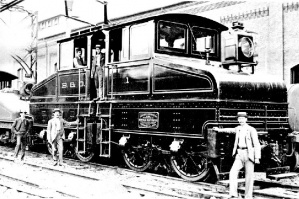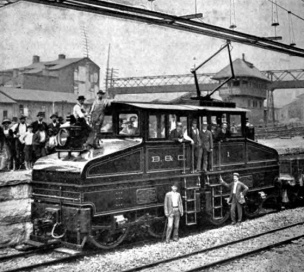Milestones:Mainline Electrification of the Baltimore and Ohio Railroad, 1895: Difference between revisions
m (Text replace - "[[Category:Power,_energy_&_industry_applicationss" to "[[Category:Power,_energy_&_industry_applications") |
m (Text replace - "[[Category:Scientific_tools_and_discoveries" to "[[Category:Engineering fundamentals") |
||
| Line 38: | Line 38: | ||
[[Category:Power_engineering|{{PAGENAME}}]] | [[Category:Power_engineering|{{PAGENAME}}]] | ||
[[Category:Electrification|{{PAGENAME}}]] | [[Category:Electrification|{{PAGENAME}}]] | ||
[[Category: | [[Category:Engineering fundamentals|{{PAGENAME}}]] | ||
Revision as of 16:34, 22 July 2014
Mainline Electrification of the Baltimore and Ohio Railroad, 1895
On 27 June 1895, at the nearby Howard Street Tunnel, the B&O demonstrated the first electrified main line railroad, and commercial operation began four days later. The electrification involved designing, engineering, and constructing electric locomotives far more powerful than any then existing and creating innovative electric power generation and distribution facilities. This pioneering achievement became a prototype for later main line railroad electrification.
The proposed specific location for the plaque is at or on the exhibit covering the Howard Street Tunnel electrification, the very achievement honored by the nominated Milestone. The Howard Street Tunnel electrification exhibit is in the historic main Museum building. The matter of plaque location has been discussed with Executive Director Wilson, and he believes that the exhibit location will work. If, for some unforeseen reason, the exhibit location is not practical, a backup location is at the Education Station, a building where a number of other plaques have been installed over the years. This now backup location was mentioned in the Proposal filed in this matter in early February 2011.
Many railroad electrification experiments and projects were proposed in North America, Europe, and elsewhere during the late 19th century. Each such proposal claimed to offer one or more improvements such as reduced expense, superior speed, power, acceleration, greater efficiency, and the elimination of the open flames, hot steam, and dense smoke associated with steam locomotives. Some of these early ideas came to fruition and resulted in important advancements in electric railway technology.
On a portion of the Baltimore and Ohio Railroad (B&O) system, the company had constructed the Howard Street Tunnel that runs beneath a section of the central part of Baltimore, MD. City ordinance prevented the installation of smoke flues and vents to exhaust the heavy smoke produced by steam locomotives in the tunnel, especially when moving passenger and freight trains on the steep northbound upgrade. The need to reduce or eliminate the dense smoke and toxic fumes in the tunnel was the impetus for what became the world’s first main line railroad electrification.
The B&O project required the design, engineering, and construction of electric locomotives, supplied by General Electric, that were 10 times more powerful than any electric locomotives built and operated up to that time. It was also necessary to design, engineer, and build large direct current (dc) power generating facilities and the entire distribution system required to provide power to the locomotives, tunnel lighting, and other electric power needs. Overall, the B&O project required that electric street railway technology, then less than six years old, be advanced and scaled up to provide railroad operation equal in power to that offered by steam locomotives, which were, at that time, the product of more than sixty years of practical experience and continued design and engineering improvement.
The first demonstration of the resulting B&O main line railroad electrification took place on 27 June 1895, and commercial operation began on 1 July of that year. The immediate success of the Howard Street Tunnel railroad electrification demonstrated to the world the practicality of electric propulsion of railroad locomotives. Within five years, major terminal electrification projects were planned in cities such as New York City and Paris, and the electrification of both local and long-distance railroads was being researched and planned in North America, Europe and elsewhere.
Attached to this nomination form is the following article that provides further background as well as design and construction details concerning the nominated Milestone achievement. The article also cites additional references under “For Further Reading.”
The Baltimore and Ohio electric mainline served as a prototype for later main line electrification projects throughout the railroad industry. The project called for the design, engineering, and construction of the powerful electric locomotives and all of the other associated facilities needed to produce and supply the direct-current (dc) electric power required. All in all, the Howard Street Tunnel railroad electrification proved that suitable railroad electrification technology could be designed, engineered, and manufactured for standard and heavy-duty main line railroad use.
References and Further Reading
Joseph J. Cunningham, “Howard Street Tunnel, origins of main line railroad electrification,” IEEE Power & Energy Magazine, vol. 8, no. 1, pp. 62 – 71, Jan./Feb. 2010. Howard Street Tunnel.pdf
Hamilton Ellis, The Pictorial Encyclopedia of Railways, the Hamlyn Publishing Group Ltd, Middlesex, UK, 1968, pp. 430-432.
David Jackson (Editor), A Guide to Trains, Fog City Press, San Francisco, 2002,
pp. 54-55.

